
| Home | Deepsky Atlas | TheAstronews | Links | Solar System | ||||||

Hawaiian Astronomical SocietyConstellations: Virgo -- Death or Life, It's all in the Family |
||||||||||
When Demeter discovered her precious daughter missing, she began a frantic search. She sought her without ceasing, not eating or sleeping. At last she learned Hades had taken her daughter; she went to persuade Hades to give her daughter back, but he would not listen to her. In her grief, she failed in her duties as goddess of agriculture. That year was the most dreadful and cruel ever experienced by humanity. No seed sprang up from the ground. People died of starvation and Demeter herself looked feeble. After watching the famine's progression, Zeus took matters into his own hand. He spoke gently to Demeter, trying to persuade her to do her job. But she would not listen, and replied she would never let anything grow on the earth until she saw her child, Persephone.
Zeus realized his brother Hades must yield. He eventually did, and Zeus told Demeter that her daughter could come home, provided she had not eaten anything while in the underworld. He sent Hermes (the messenger) to the underworld to fetch Persephone. Hades, downcast, knew he must obey the word of Zeus. Persephone was elated to hear the news that she could finally return to her mother. Before her departure with Hermes, Hades told her not to forget him, and to think kindly of him. He tricked her to eat a few pomegranate seeds, knowing in his heart that if she did so she must return to him.
Demeter and Persephone had a happy reunion, they had a lot to talk about. Demeter grieved when she learned about the pomegranate seeds. Zeus sent his mother Rhea to speak to Demeter. Rhea explained that Persephone could remain with her 8 months out of a year, but the rest of the year, she has to go back down to the underworld to be with Hades. Demeter understood and apologized for the desolation she had brought about. She made the fields rich and productive again, but during the four months that Persephone is in the underworld, she still grieves for her daughter, letting winter rule the world.
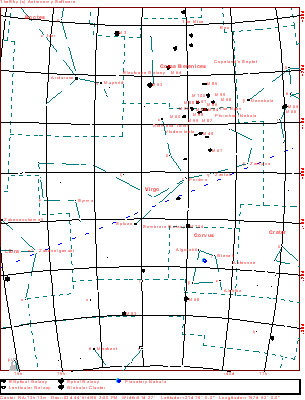
Click the map for a 916x1200 version of the above. Click here for a map better suited for use in the field.
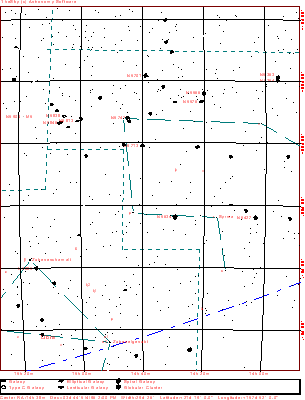
This a more detailed view of the constellation. The map displays stars to magnitude 10, and deepsky objects to magnitude 12. Click here for a map better suited for use in the field.
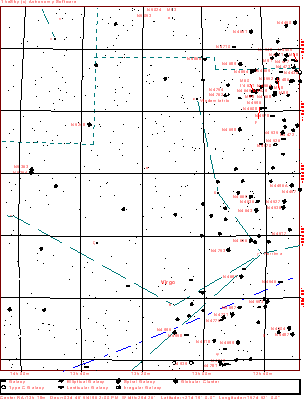
Click here for a map better suited for use in the field.
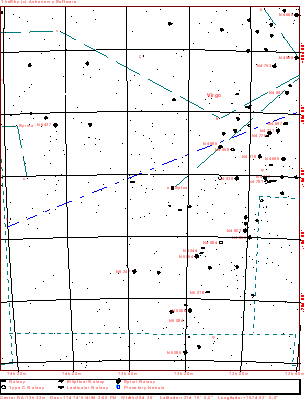
Click here for a map better suited for use in the field.
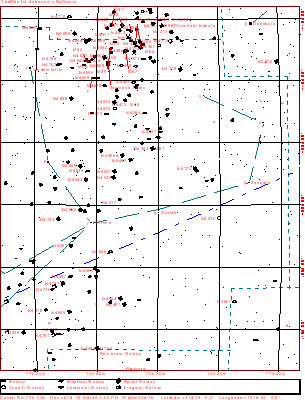
Click here for a map better suited for use in the field.
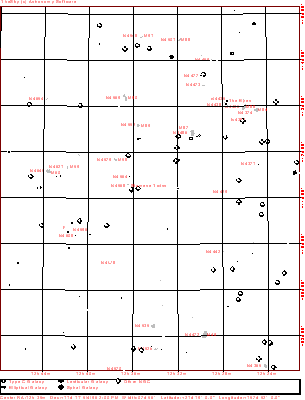
Click here for a map better suited for use in the field.
 47k JPEG NGC5746 (Best 110) is an edge on spiral galaxy located in far eastern Virgo, 20' WNW of the mag. 3.8 star 109 Viginis. The NGC description reads: Bright (mag. 11.6), large (7.5'x1.3'), very much elongated (p.a. 170°), with brightening toward a very pronounced nucleus. Larger aperture (14" and up) under dark conditions may show a dark lane. 47k JPEG NGC5746 (Best 110) is an edge on spiral galaxy located in far eastern Virgo, 20' WNW of the mag. 3.8 star 109 Viginis. The NGC description reads: Bright (mag. 11.6), large (7.5'x1.3'), very much elongated (p.a. 170°), with brightening toward a very pronounced nucleus. Larger aperture (14" and up) under dark conditions may show a dark lane.
NGC5740 lies 18' to the SSW of NGC5746. Its description reads: Fairly bright (mag. 12.7), large (3.0'x1.5'), somewhat vaguely round, and brightening slowly toward the middle. Larger aperture (12") may show mottling.
Image from the Digital Sky Survey.
|
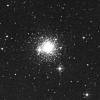 40k JPEG NGC5634 (Bennett 66) is a globular cluster located in eastern Virgo midway between Mu and Iota Virginis. It's described as very bright (mag. 9.6), quite large (4.9'), round, with a gradually brighter middle. It is well resolved, with stars of magnitude 19. An 8th magnitude star lies southeast. Even given the NGC's propensity to overstate magnitudes, this one requires a telescope in the 16" to 20" class to begin to resolve. Image from the Digital Sky Survey. 40k JPEG NGC5634 (Bennett 66) is a globular cluster located in eastern Virgo midway between Mu and Iota Virginis. It's described as very bright (mag. 9.6), quite large (4.9'), round, with a gradually brighter middle. It is well resolved, with stars of magnitude 19. An 8th magnitude star lies southeast. Even given the NGC's propensity to overstate magnitudes, this one requires a telescope in the 16" to 20" class to begin to resolve. Image from the Digital Sky Survey.
|
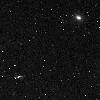 80k JPEG NGC4697 (Caldwell 52) is an elliptical galaxy located 4.7° SSE of Porrima (Gamma Andromedae. Dreyer calls it very bright (mag. 9.9), large (6'x3.8'), elongated (P.A. 45°, and containing a pronounced core. It sits at the top, right (north-west) of the image, surrounded by a host of fainter galaxies. At the bottom, left is NGC4731, a very faint (mag. 11.6), fairly large (6.5'x3.4') torn up spiral. More galaxies than you can count lie between in this Digital Sky Survey image. 80k JPEG NGC4697 (Caldwell 52) is an elliptical galaxy located 4.7° SSE of Porrima (Gamma Andromedae. Dreyer calls it very bright (mag. 9.9), large (6'x3.8'), elongated (P.A. 45°, and containing a pronounced core. It sits at the top, right (north-west) of the image, surrounded by a host of fainter galaxies. At the bottom, left is NGC4731, a very faint (mag. 11.6), fairly large (6.5'x3.4') torn up spiral. More galaxies than you can count lie between in this Digital Sky Survey image.
|
 43k JPEG M60 (NGC4649) and M59 (NGC4621) are the two brightest galaxies in this picture from the Digital Sky Survey. M60 is a very (?!) bright (mag. 9.6), fairly large (3'x2.5'), elliptical galaxy. M59 (NGC4621) is a bright (mag. 10.6), fairly large (4.5'x3.5') elliptical 24' WNW of M60, 1.1° ESE of M58. The brightish spiral overlapping M60 is NGC4647. Between the two Messier galaxies and beneath (south of) them are the mag. 12.2 NGC4638, and the mag. 14.8 NGC4637. The pair in the top, right are the mag. 13.9 NGC4607 and the mag 12.5 NGC4606. Many other galaxies roam this image down to mag. 17. 43k JPEG M60 (NGC4649) and M59 (NGC4621) are the two brightest galaxies in this picture from the Digital Sky Survey. M60 is a very (?!) bright (mag. 9.6), fairly large (3'x2.5'), elliptical galaxy. M59 (NGC4621) is a bright (mag. 10.6), fairly large (4.5'x3.5') elliptical 24' WNW of M60, 1.1° ESE of M58. The brightish spiral overlapping M60 is NGC4647. Between the two Messier galaxies and beneath (south of) them are the mag. 12.2 NGC4638, and the mag. 14.8 NGC4637. The pair in the top, right are the mag. 13.9 NGC4607 and the mag 12.5 NGC4606. Many other galaxies roam this image down to mag. 17.
|
 36k JPEG NGCs 4754 and 4762 (Best 109) are a pair of galaxies located 2.2° east of M60 and 2.3° west of Vindemiatrix (Epsilon Virginis). NGC4754 is a mag. 10.6 face on spiral, sized 4.6'x2.5'. It brightens quickly toward the middle. NGC4762 is edge on (8.7'x1.7') spiral shining at mag 10.3. Larger scopes will see "tufts" at either end of a bright streak. NGC4762 sits 10.4' to the ESE of NGC4754. Image from the Digital Sky Survey. 36k JPEG NGCs 4754 and 4762 (Best 109) are a pair of galaxies located 2.2° east of M60 and 2.3° west of Vindemiatrix (Epsilon Virginis). NGC4754 is a mag. 10.6 face on spiral, sized 4.6'x2.5'. It brightens quickly toward the middle. NGC4762 is edge on (8.7'x1.7') spiral shining at mag 10.3. Larger scopes will see "tufts" at either end of a bright streak. NGC4762 sits 10.4' to the ESE of NGC4754. Image from the Digital Sky Survey.
|
 170k JPEG NGC4753 (Bennett 55) is a strange little galaxy full of twisted dark lanes, and located 2.7° east of the beautiful double star Porrima (Gamma Virginis). We can't see the galaxy's strangeness. Dreyer's description reads: Quite bright (mag. 10), large (6.0'x2.8'), very little extended (in p.a. 80°), very gradually brightening a little toward the middle. A nucleus appears with averted vision with an 8" and becomes more pronounced in larger instruments. CCD image from the 2.5m (98") Sloan Digital Sky Survey telescope. 170k JPEG NGC4753 (Bennett 55) is a strange little galaxy full of twisted dark lanes, and located 2.7° east of the beautiful double star Porrima (Gamma Virginis). We can't see the galaxy's strangeness. Dreyer's description reads: Quite bright (mag. 10), large (6.0'x2.8'), very little extended (in p.a. 80°), very gradually brightening a little toward the middle. A nucleus appears with averted vision with an 8" and becomes more pronounced in larger instruments. CCD image from the 2.5m (98") Sloan Digital Sky Survey telescope.
|
 36k Labeled JPEG M58 (NGC4579) is a spiral galaxy with what may be a central bar. It lies 1.1° WNW of M59, and 54' south-east of M89. Dreyer calls it bright (mag. 11), large (6'x5'), irregular, and quite condensed. It's compactness makes this galaxy easier to view than the magnitude would indicate. 36k Labeled JPEG M58 (NGC4579) is a spiral galaxy with what may be a central bar. It lies 1.1° WNW of M59, and 54' south-east of M89. Dreyer calls it bright (mag. 11), large (6'x5'), irregular, and quite condensed. It's compactness makes this galaxy easier to view than the magnitude would indicate.
NGC4564 lies 30' southwest of M58. Dreyer describes it as fairly bright (mag. 11.9), small (3.5'x1.5'), showing little elongation (!?, this is an edge on spiral), and brightening fairly suddenly toward the middle. A galaxy pair called the Siamese Twins (Best 107) lies 11' south of NGC4564. Consisting of NGCs 4567 and 4568, they are described as very faint (mag. 12) and large (4'x3' combined). Visible in an 8", this pair will look like a single, curved glow. Larger instruments will show brightening toward the middle in NGC4567 (the more northerly one).
Image is from the Digital Sky Survey.
|
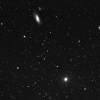 82k JPEG M89 (NGC4552) and M90 (NGC4569) are again the two brightest galaxies in this picture from the Digital Sky Survey. M90 is a mag. 11, pretty large (11'x5'), spiral with a diffuse bar. It lies 2.2° east of the Eyes (see below). M89 is a bright (mag. 10.5), fairly small (5'x5') elliptical 40' SW of M90. Just above (north of) M90 lies IC3583 (mag. 13.8). At the extreme right edge of the picture lies NGC4531 at mag. 12.4. 82k JPEG M89 (NGC4552) and M90 (NGC4569) are again the two brightest galaxies in this picture from the Digital Sky Survey. M90 is a mag. 11, pretty large (11'x5'), spiral with a diffuse bar. It lies 2.2° east of the Eyes (see below). M89 is a bright (mag. 10.5), fairly small (5'x5') elliptical 40' SW of M90. Just above (north of) M90 lies IC3583 (mag. 13.8). At the extreme right edge of the picture lies NGC4531 at mag. 12.4.
|
 52k Labeled JPEG. The Markarian Chain of galaxies sits at the center of the Virgo Cluster of Galaxies. You get there by pointing your telescope mid way between Denebola (Beta Leonis) and Vindemiatrix (Epsilon Virginis). A galaxy pair called "the Eyes" (NGCs 4435 & 4438) anchors its center. NGC4438 (Best 104) is bright, fairly large, elongated in larger scopes, and showing a little mottling in a 13". Its mate to the north (NGC4435) is fairly bright (11.7) and quite large(?!), and round (2.8'x2'). 52k Labeled JPEG. The Markarian Chain of galaxies sits at the center of the Virgo Cluster of Galaxies. You get there by pointing your telescope mid way between Denebola (Beta Leonis) and Vindemiatrix (Epsilon Virginis). A galaxy pair called "the Eyes" (NGCs 4435 & 4438) anchors its center. NGC4438 (Best 104) is bright, fairly large, elongated in larger scopes, and showing a little mottling in a 13". Its mate to the north (NGC4435) is fairly bright (11.7) and quite large(?!), and round (2.8'x2').
23' west of the Eyes lie the large elliptical galaxies M86 (NGC4406, mag. 9.8, size = 9'x6') and M84 (NGC4374, mag. 10, size = 6.4'x5.6'). M86 wears a ring of galaxies like a necklace. They should be viewable in 8"-10" telescopes. NGC4402 (mag. 12.8, 3.9'x1.1') lies to the north. NGC4387 (mag. 13, 1.8'x1.1') lies south-west. NGC4388 (Best 103, mag.11.9, 5.6'x1.3') lies SSW. NGC4413 (mag. 13, 2.3'x1.5') lies SSE. NGC4425 (mag. 12.9, 3'x1') lies south-east. 58' south-west of the Eyes lies the giant elliptical galaxy, M87 (NGC4486, mag. 9.6, size = 7'x7'). A mag. 8.5 star sits just to its north. Three associated galaxies lie just to its south and east. To the south is NGC4486a (mag. 12.8, .8'x.7'). NGC4478 (mag. 12.3, 1.9'x1.6') lies to the WSW. NGC4476 (mag. 13.1, 1.7x1.2) lies just to the east of NGC4478. The chain extends east and north of the Eyes, as well. 22' ENE lie another pair. NGC4461 is a faint (mag. 12), elongated (in larger scopes, 3.5'x1.4') spiral. NGC4458 lies just to its north. Although Dreyer calls this one "bright (mag. 13)," it is harder to see than its mate (which Dreyer called faint). Heading another 18' north-east up the chain reveals NGC4473. Dreyer calls it fairly bright (mag. 11.1). Its size is 4.4'x2.5'. This is probably the richest area of the Virgo Supercluster of galaxies.
Image is a mosaic of six Digital Sky Survey downloads.
|
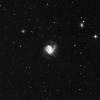 29k JPEG M61 (NGC4303) is the spiral galaxy that centers this picture from the Digital Sky Survey. Dreyer describes it as very bright (mag. 10.1), very large (7'x6') object that shows structure in mid to large amateur instruments. Another mag. 13.6 spiral galaxy (NGC4303a) sits in the 10:00 o'clock position (NE). NGC4292 (mag. 13.6) sits in the 2:00 (NW) position. 29k JPEG M61 (NGC4303) is the spiral galaxy that centers this picture from the Digital Sky Survey. Dreyer describes it as very bright (mag. 10.1), very large (7'x6') object that shows structure in mid to large amateur instruments. Another mag. 13.6 spiral galaxy (NGC4303a) sits in the 10:00 o'clock position (NE). NGC4292 (mag. 13.6) sits in the 2:00 (NW) position.
|
 30k Labeled JPEG NGC4216 (Best 102) sits almost on the border of Coma Berenices. It lies 1.5° SSW of M99, 1.8° SSE of M98, and 2.3° west of M84. It anchors a series of galaxies. 30k Labeled JPEG NGC4216 (Best 102) sits almost on the border of Coma Berenices. It lies 1.5° SSW of M99, 1.8° SSE of M98, and 2.3° west of M84. It anchors a series of galaxies.
Mid way between M84 and NGC4216 lies NGC4267 (mag. 11.8, 3.2'x3.0', not pictured). Dreyer describes NGC4216 itself as very bright (mag. 11), very large (8.2'x1.8'), very much elongated (p.a. 17°), and brightening suddenly to a central nucleus. A classic edge on spiral in a 6" to 8", larger instruments bring out the oval center, and extend the size of the arms. Two fainter edge on galaxies lie in the same eyepiece field as NGC4216. The first is NGC4222 (mag. 14, 3.3'x0.5'), lying 12' to the northeast. It requires dark skies and perhaps a 12". The second is NGC4206 (mag. 13, 5.1'x1.0'), 12' to the southwest. This should be a little easier to spot. Moving 29' west from NGC4216, we come to NGC4193 (mag. 13, 2.0'x1.1'). This, too, is very faint. 15' north of NGC4193 is NGC4189 (mag. 12.6, 2.4'x1.7'), in Coma Berenices). Not as faint as its companion, it may look mottled in larger instruments. Travel a further 24' west from NGC4193 and we come to NGC4168. Described as fairly bright, fairly large, irregular in shape, and brightening fairly suddenly toward the middle, it should appear mottled in larger instruments. There are faint stars involved. NGC4212 lies in Coma Berenices, 45' north of NGC4216. Its description reads bright, large, elongated (p.a. 107°). It brightens, first gradually, then suddenly toward the middle. 12" and larger instruments may show mottling.
Image is a mosaic of 4 downloads from the Digital Sky Survey.
|
 33k Labeled JPEG NGC4699 (Bennett 54, Best 108), located in southern Virgo 1.6° north-west of Psi Virginis, anchors a field of galaxies. Described as very bright (mag. 10.7), round (3.8'x2.6'), with a very much brighter middle. Steve Coe writes that in a 13" the galaxy tends to "grow" with averted vision. The next brightest galaxy, NGC4759 lies 1.1° ESE. Dreyer describes this mag. 12.2 galaxy as fairly large (2.6'x2.0'), part of a double galaxy (the other portion being NGC4764). A mag. 10 star sits 2' to the south-west. Much more challenging are NGC4739, located 41' ENE of NGC4699, and IC3826, located 32' southeast, both shining at mag. 13.5. NGC4703, located 27' south of NGC4699, shines at mag. 14.5. Image is a mosaic from the Digital Sky Survey. 33k Labeled JPEG NGC4699 (Bennett 54, Best 108), located in southern Virgo 1.6° north-west of Psi Virginis, anchors a field of galaxies. Described as very bright (mag. 10.7), round (3.8'x2.6'), with a very much brighter middle. Steve Coe writes that in a 13" the galaxy tends to "grow" with averted vision. The next brightest galaxy, NGC4759 lies 1.1° ESE. Dreyer describes this mag. 12.2 galaxy as fairly large (2.6'x2.0'), part of a double galaxy (the other portion being NGC4764). A mag. 10 star sits 2' to the south-west. Much more challenging are NGC4739, located 41' ENE of NGC4699, and IC3826, located 32' southeast, both shining at mag. 13.5. NGC4703, located 27' south of NGC4699, shines at mag. 14.5. Image is a mosaic from the Digital Sky Survey.
|
 32k Labeled JPEG. M49 (NGC4472) is a mag. 9.1 elliptical galaxy, 8'x7' in size. Located 5° south of M87, Dreyer describes it as very bright (mag. 9.1), large (10.3'x8.4'), round, and condensed. It is flanked by the rather faint NGC4535 (Best 106, mag. 10.5, 7.1'x5') and the much brighter NGC4526 (30' south of 4535) to the east, and NGC4365, 1.5° to the WSW. 32k Labeled JPEG. M49 (NGC4472) is a mag. 9.1 elliptical galaxy, 8'x7' in size. Located 5° south of M87, Dreyer describes it as very bright (mag. 9.1), large (10.3'x8.4'), round, and condensed. It is flanked by the rather faint NGC4535 (Best 106, mag. 10.5, 7.1'x5') and the much brighter NGC4526 (30' south of 4535) to the east, and NGC4365, 1.5° to the WSW.
A host of fainter galaxies surrounds M49 closer in. Located 5° S of M87 and 1.1° ESE of M49, NGC4526 (Best 105) shines at mag. 9.6 and is 5'x2' in size. Dreyer describes it as bright, elongated (position angle 120°), and brightening suddenly toward the middle. NGC4570 is a spiral galaxy located 50' southeast of NGC4526. Dreyer describes it as quite bright (mag. 11.9), fairly small (.8'x1.1'), much elongated (a p.a. of 159°), with a sharp brightening toward a mottled nucleus. A very pretty spindle.
Image is a three download mosaic from the Digital Sky Survey.
|
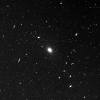 50k Labeled JPEG. NGC4365 is another Virgo eliptical galaxy hosting its own swarm of fainter galaxies. It sites 1.5° WSW of M49. Described as quite bright (mag. 10.3), fairly large (7.0'x5.1'), with very little elongation, it shines evenly, except for a much brighter nucleus. 50k Labeled JPEG. NGC4365 is another Virgo eliptical galaxy hosting its own swarm of fainter galaxies. It sites 1.5° WSW of M49. Described as quite bright (mag. 10.3), fairly large (7.0'x5.1'), with very little elongation, it shines evenly, except for a much brighter nucleus.
Image is from the Digital Sky Survey.
|
 42k GIF. M104 (NGC4594) is a mag. 8.6 galaxy, 9'x4' in size. Seen edge on from earth, even a 4" telescope will the dust lane running through its center. It lies on the border of Corvus, the crow. 42k GIF. M104 (NGC4594) is a mag. 8.6 galaxy, 9'x4' in size. Seen edge on from earth, even a 4" telescope will the dust lane running through its center. It lies on the border of Corvus, the crow.
|
 41k Labeled JPEG. NGC5068 (Bennett 59a) anchors a trio of galaxies near the Hydra border, 2° north of Gamma Hydrae. Dreyer calls it faint (mag. 10.4), large (7.2'x6.3'), irregularly round, and with a brighter middle. 41k Labeled JPEG. NGC5068 (Bennett 59a) anchors a trio of galaxies near the Hydra border, 2° north of Gamma Hydrae. Dreyer calls it faint (mag. 10.4), large (7.2'x6.3'), irregularly round, and with a brighter middle.
NGC5087 lies half a degree north-east of NGC5068. Its description reads: Quite faint (mag. 12), very small (2.3'x1.7'), and irregularly shaped. In an 8" to 10", this is one you might suspect is there if you know where to look. NGC5084 lies 51' SSE of NGC5068. Dreyer's description reads: Quite bright (mag. 11.3), quite small (9.3'x1.8'), and very little extended (80°). It is brightest to the east side. In fact, this is an edge on spiral, but the extensions are hard to see.
Mosaic from the Digital Sky Survey. Many additional, faint, small galaxies are visible in the larger image.
|
If you have any questions about the Hawaiian Astronomical Society
please
(link requires javascript).